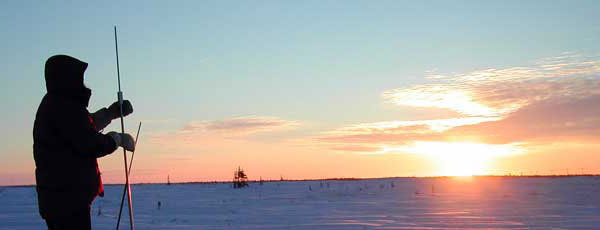Climate Change at the Arctic's Edge
- Churchill Northern Studies Center, Arctic
- Volunteer Vacations

| from $2,995* per person | 10 Days | February, June, August, September |
| Simple accommodations | Exertion level: 5 | |
| Operator: Earthwatch Institute | 12 people max | |
Loading map, please wait...
Locations visited/nearby
Churchill , Manitoba , climage change , glaciers , carbon , permafrost , arctic , climate change at the artic's edge, Canada
0 testimonials about this trip.
1 testimonial about the provider, Earthwatch Institute:
-
Reviewer: L. Reifschneider
located in
St. Louis,
MO
USA
Elephant conservation is what drives my travel destinations. However, I always come home counting the blessings of new friends and an understanding of a culture and way of life I possibly would otherwise have never been introduced to. Through the Earthwatch projects I participate in, I am learning just how big and wonderful this world is.
Itinerary
On the ExpeditionHelp show how much and how fast climate change is affecting the Arctic — and what that means for the entire planet.
In this inimitable Arctic landscape, you’ll study climate change at sites ranging from the tundra into the forest by monitoring changes affecting the gases stored in these peat-rich ecosystems. Summer and fall teams will use ground-penetrating radar, microclimate dataloggers, and soil coring to measure the permafrost’s organic carbon levels. You’ll also live-trap small mammals, evaluate growth rings in trees and shrubs through sampling, and monitor plant development. February teams will experience the Arctic’s edge in its most dramatic season. Traveling by gamutik (sled) towed by snowmobiles, you’ll classify ice crystals, and measure snowpack thickness, density, and temperature. You can also learn how to build an igloo and sleep in it comfortably, even when the temperature outside is -30 or -40 degrees Celsius.
Meals and Accommodations
You’ll be based at the Churchill Northern Studies Center, featuring dramatic scenery and a dome for watching the Arctic sky, where you may catch a glimpse of the Northern Lights. You’ll stay in dormitory rooms with up to eight beds in each, a quiet lounge for reading, and shared modern washroom facilities with hot showers. Meals will be provided by the Center’s cafeteria and will be varied, typically including a choice of salads, desserts, and a vegetarian alternative, along with fresh breads and evening snacks.
About the Research Area
Churchill is located at the northern edge of the forest-tundra near the geographical center of the North American continent. It’s on the coast and within the Hudson Bay Lowlands, the largest peatlands in North America, situated at the mouth of the Churchill River. Many different biomes can be found in the vicinity, including forest, forest-tundra, tundra, wetland/peatland, estuarine, and marine.
The land around Churchill is emerging from Hudson Bay as the earth’s crust rebounds from the weight of the last ice age’s glaciers at the rate of 80-100 centimeters a century. As land rises, raised beach ridges are formed and stand out in relief against the lowlands. Plant diversity is high for this latitude because Arctic, sub-Arctic, and Boreal species all meet in the region. Accordingly, Churchill is a favored area for the study of primary plant community succession.
More information from Earthwatch Institute:
- View trip on provider's website
earthwatch.org/expeditions/climate-change-at-the-arctics-edge… - Company profile, experience, and history
- View all of their trips
- Email this trip page to a friend
-



Comments from Facebook